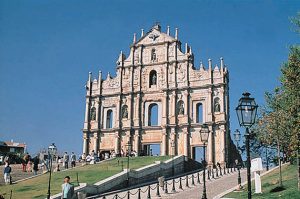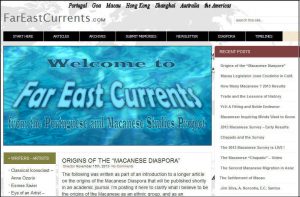 The search for cultural identity, no matter how it is conducted, is usually a personal activity that is likely to be on most people’s “bucket list”. Learning about where your family originated, or who specific members were and how they lived, can include on-line searches of ancestral databases, visits to libraries and archives, DNA testing, and travel to little known corners of the world. The process of finding this information can itself be a powerful and emotional journey, connecting people from common backgrounds while engaging them in a search for cultural roots that may have been hidden from view.
The search for cultural identity, no matter how it is conducted, is usually a personal activity that is likely to be on most people’s “bucket list”. Learning about where your family originated, or who specific members were and how they lived, can include on-line searches of ancestral databases, visits to libraries and archives, DNA testing, and travel to little known corners of the world. The process of finding this information can itself be a powerful and emotional journey, connecting people from common backgrounds while engaging them in a search for cultural roots that may have been hidden from view.
This is the case of Macanese in the Diaspora, and perhaps the Macanese in general. But the difference in how people reconnect seems to be determined by generation. Many Macanese left Macau and other expatriate communities after World War II, and continued to migrate to Europe, the Americas, and Australia through the 1980s. Some remained connected through Casa de Macau associations that meet every three years at “Encontros” organized by the Conselho das Comunidades Macaenses (CCM). Among younger generations of Macanese, however, notions of Macau and Macanese community life are often filtered through the nostalgic, and often imperfect, impressions of their parents, grandparents, and other relatives who were among the first immigrant groups. In the absence of written history, most Macanese are left with little information beyond fading memories that link them to the past. As a result, the cultural connection of their children and grandchildren to Macau begins to diminish as life in adopted countries takes over.
This condition has not prevented some Macanese from returning or from beginning a search for cultural origins. An increasing number are now working professionals in economically developed countries who are searching for more accurate information about their family’s connection to Macau through the internet and other related platforms. To understand how this process of engagement occurs in practice, I offer my own experience over the last few years. While the following process may not be typical, it nevertheless illustrates how Macanese inside and outside Macau have “reconnected” to form a network of interested observers.
Reconnecting with Macau
My interest in the Macanese (whom I define as anyone with familial or cultural ties to Macau) began after the 1996 publication of “Familias Macaense”, a three volume set written by Jorge Forjaz, a Portuguese genealogist. A frequent visitor to Macau, Forjaz based his work on the archival records of over 50,000 Portuguese, Macanese, Chinese, and other Southeast Asian descendants. Included in the research are important clues as to when and where the earliest ancestors originated. There is also an on-line version, but access is currently restricted, which I will discuss in a later article. Revised print editions are due in 2017.
Although it was a few years before I began my studies, Forjaz’s data allowed me and many other Macanese to trace the origins of our families from as early as 1150 AD. As a sociologist and historian, my interest in Forjaz’s research, especially his references to villages and towns in Portugal, India, and other Asian locations, also stimulated a desire to learn about Portuguese history in general, and the Portuguese overseas empire in particular, especially how the latter influenced the development of Macau.
My research began in earnest with the collection of historical materials from relatives, friends and colleagues. I also visited numerous libraries and archives, and conducted an extensive review of past studies, books, and articles in Portuguese and English. (This research also included frequent visits to Macau and Hong Kong beginning in 2013 for site visits and interviews.) I was fortunate to find original source material, some translated from Chinese, dating from as early as the 15th and 16th centuries that was recently digitized and available on-line. I noticed early on that many items provided important historical details about Macau’s past that were not mentioned anywhere else, and often enhanced information provided in academic articles and studies that I was reading.
As I began to learn from the materials, there was a continual discovery of personal stories associated with some artifacts, which were illuminated when placed within a historical context. Some of the information I unearthed, for example, revealed the contrasts in community life in Hong Kong and Shanghai before and after World War II. I soon realized that early nostalgic impressions were significant for those who remained in Macau and for those relatives who migrated to both European settlements. Reading back on Macau’s history, similar contrasts could be seen before and after the Opium Wars from 1841 through 1860, as well as from the founding of Macau from 1557 to about 1690, corresponding to its “Golden Age” through the rise of the global “China Trade”. More archival work revealed that during these periods the Macanese community was highly migratory, which had not been studied in detail. In fact, the community’s continual resettlement outside Macau since its founding seemed to be a fundamental trait beginning with the first appearance of racially-mixed ancestors in India and throughout Southeast Asia.
The collection of this historical material led to several short articles, some of which were published in association newsletters and academic journals, including the Instituto Cultural’s Review of Culture and the Journal of the Royal Asiatic Society in Hong Kong. In the process, the research began to attract the interest of sponsors that could assist in gathering more materials. These included the Institute for the Study of Societal Issues (ISSI) at U.C. Berkeley and Berkeley’s Bancroft Library – Portuguese in California Project. Other sponsors include Uniao Macaense Americana, the oldest Casa de Macau association, the Lusitano Club of California, the world’s largest Casa de Macau association, and the Alianca Internacional Macaense, an independent association registered in Macau. (I am currently a member of each organization.) In order to maximize my efforts, I then created an on-line research site called FarEastCurrents.com, which is officially named “The Portuguese and Macanese Studies Project” and affiliated with ISSI at the University of California.
Creating a Macanese Network

The appearance of Far East Currents and the growing number of people who have visited since its launch in 2012 essentially created the means to gather contact information and to engage new generations of Macanese. Their initial interest in Macau’s history and the role that Macanese from different ethnic communities played has led to renewed interest in the MSAR.
To learn more about these new users, the next phase of the project was to use their interest in Macau to develop a master contact list, then to use that list to maintain a dialogue through regular articles, submission pages to the website for images and documents, and other features including periodic surveys.
The growth of other web and social media sites created by Macanese world-wide has further enhanced these efforts, increasing the reach of Far East Currents.com to a much larger audience based on sharing over smartphones and other mobile devices, which appear not to be restricted by language or international borders. In order to illustrate the development of this network, what we know about its users, and to understand the impact that their collective influence may have on Macau in the future, the next article will review its creation in recent years.
Please stay tuned.
More Stories
Studies of China’s GBA: U.S. – Chinese Interdependence after the Pandemic
Colonial Journalism in 19th Century Macau and Hong Kong
Women and Cultural Boundaries in Macau